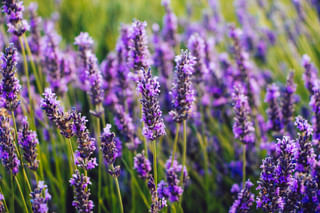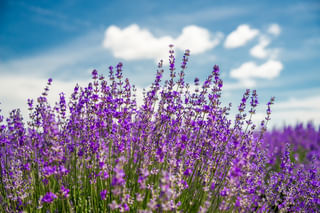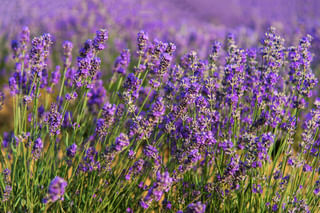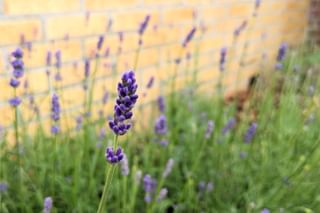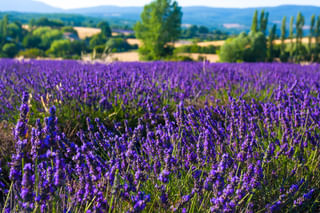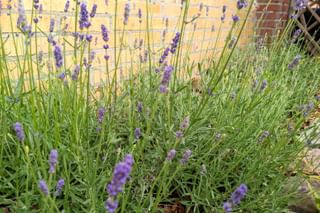How to take care of Lavender
In this plant care guide we'll look at how you can take care of your lavender plants, from the time you bring them home until they have grown into healthy and happy plants in your house!
If you are new to houseplants, lavender is a great one to start with. It is easy to take care of and doesn't require much maintenance. In this plant care guide, we'll look at how to water and fertilize your lavender plants and deal with common pests and diseases. I will also provide some tips on keeping your lavender plants looking their best all year!
Let's look at how we can take care of this versatile plant!
How often should I water my lavender plant?
Plants need water to grow happy and healthy. Lavender plants should be watered about once a week, or when the soil is dry to the touch. They are drought-tolerant plants and can withstand periods of dryness, but they will not produce as many flowers if they are not watered regularly.
When you water your Lavender too much, it has a higher chance of getting root rot, which will most likely kill the plant. Younger plants should be watered a little more often though because they're still developing their roots and need extra moisture to grow. Once they've settled into their growing environment, they won't need to be watered as much anymore.
How much water should I give my lavender plant?
When watering your lavender plant, be sure to give it enough water so that the soil is moist but not soggy. Too much water can cause the roots to rot, so it's important to find a happy medium. To check if your lavender plant needs water, use your finger to feel the top inch of the soil. If it feels dry, add water until it drains out of its pot. If the soil is moist, no water is needed yet.
On average, you should water once per week if you've got well-draining, sandy soil.
How much sunlight does lavender need?
Lavender thrives best in full sunlight, requiring at least six to eight hours of direct sunlight daily. During especially warm summer days, a bit of afternoon shade can help the plant from drying out too quickly.
To ensure your lavender plant receives the optimal amount of sunlight, place it in a south-facing window if possible. South-facing windows usually provide the most consistent and direct sunlight throughout the day. If a south-facing window is not available, a west-facing window can also work, but make sure the plant gets at least six to eight hours of direct sunlight daily.
If you're growing lavender outdoors, choose a spot in your garden that gets full sun for most of the day.
What type of soil should I use for my lavender plant?
To take care of lavender, it is important to use the right soil. Lavender prefers sandy, well-draining soil. You can either create your own mix or purchase a commercial blend specifically made for lavender. If your soil is heavy or clay-like, you can mix in some perlite or sand to improve drainage.
Keep in mind that Lavender is very drought tolerant, which means it prefers to be dry, rather than sit in wet soil. So a mix that contains sandy and/or perlite is essential for your Lavender to be happy and healthy.
Should I fertilize my lavender plant?
Lavender is a plant that is known for being able to grow in infertile soil, where no other plant can survive. This makes it a fantastic plant for you if you forget to fertilize your plants all the time, or you just want a low-maintenance flowering plant.
Although fertilizing your lavender plant is not necessary, if you want to encourage growth and flowering, you can fertilize it once at the beginning of spring when new growth begins. Lavender does not need a lot of fertilizer, but adding a little fertilizer to the soil once per year will help to keep your lavender thriving for years.
Fertilizing your lavender can help to improve the soil a little bit, which will make it an excellent growing environment for your plant to grow for many years.
How and when should I prune my lavender plant?
Pruning lavender is important for maintaining its shape, encouraging new growth, and preventing the plant from becoming woody and leggy. Here's how and when you should prune your lavender plant:
When you should prune
- In the spring: As new growth begins in early spring, around March or April, prune back any dead or damaged branches to encourage healthy new growth.
- In the summer: After the first flowers have faded, usually in mid to late summer, trim the dead leaves and flowers back. This helps promote a second bloom and keeps the plant compact.
- In the fall: Lightly shape the plant in late fall before the first frost, but avoid heavy pruning as this can expose the plant to winter damage.
How you should prune
- Use sharp, clean pruning shears to make precise cuts and minimize plant stress.
- For young plants (first year), only pinch off the tips of the new growth to encourage business.
- For established plants, cut any leggy growth back to keep the plant compact. Avoid cutting into the woody, older stems as lavender does not regenerate well from old wood.
- Aim for a rounded, mound-like shape to maintain good air circulation and aesthetic appearance.
- If you're pruning after the flowers have bloomed, you can trim the flower stems for drying or use them fresh.
By following these guidelines, your lavender plant will stay healthy, vibrant, and productive year after year.
Can I propagate my lavender plant?
You can propagate your lavender plant through several methods, with stem cuttings being the most popular and effective. Here's a guide on how to propagate lavender using this method:
Step 1: Gather materials
- Sharp, clean pruning shears or scissors
- Rooting hormone (optional but recommended)
- Small pots or seed trays
- Well-draining potting mix (a mix of sand and compost works well)
Step 2: Take cuttings
The best time to take cuttings is in the summer when Lavender is actively growing. Choose a healthy, non-flowering stem that is green and flexible (also known as softwood). Cut a 4-6-inch section of the stem just below a leaf node.
The reason you don't want a flower, or even a flower bud on the cutting is because that takes too much energy to grow. A cutting without a bud can focus on growing roots instead.
Step 3: Prepare the cuttings
After taking your cutting(s), strip the leaves from the bottom half of the cutting, leaving a few leaves at the top. (Optionally) Dip the cut end of the stem into the rooting hormone to enhance root development.
By removing the lower leaves, you give the stem plenty of space to grow roots. The leaves would only start to rot when they get in contact with the soil, so it's best to remove them.
Step 4: Plant the cuttings
To plant the cuttings, fill small pots or seed trays with the well-draining potting mix. Insert the cuttings into the soil, burying the lower part without leaves. Make sure the cuttings are planted firmly to avoid air pockets. Water lightly to settle the soil around the cuttings. Keep the soil lightly moist, not soggy.
Step 5: Patience (sorry)
Now comes the hardest part of propagating Lavender: Patience. After about 4-6 weeks, check for root development by gently tugging on the cuttings. If they resist, roots have started to grow. Once roots are established, transplant the cuttings into larger pots or directly into the garden in a well-draining, sunny spot.
When do I harvest the lavender flowers?
Lavender can be used for many things, including making tea, essential oils, and other aromatherapy products. So you might be wondering how you can harvest your lavender plant(s) to incorporate into other products. Let's find out how and when you should harvest your lavender!
The best time to harvest lavender flowers is in the morning after the dew has evaporated but before the heat of the day sets in. Harvest lavender flowers when they are in full bloom. You can determine when it is ready to harvest by looking for buds that are starting to turn purple. To harvest, cut the stem about an inch below the flower head. You can harvest lavender flowers up to twice a week, but make sure to leave enough flowers on the plant so it can continue to bloom.
How do I dry the lavender flowers?
Once you have harvested your Lavender flowers, you'll want to dry them to use in other products. To dry the lavender flowers, tie them in bunches and hang them upside down in a dark, cool, and well-ventilated area. Once the flowers are completely dry, you can remove the stems and store the flowers in an airtight container.
How can I prevent and treat common pests on Lavender plants?
Lavender is pretty tough against pests thanks to its aromatic oils, but it can still get hit by some common bugs. Here's how to prevent and deal with pests that can affect your lavender plants:
Prevention
Preventing pests is the best way to keep your plant healthy. The most effective way to prevent pests is to make sure your plant is healthy. A healthy plant can keep pests away. This means you should make sure to water your plant properly to prevent watering issues and weakening your plant.
As well as staying healthy, your Lavender should have enough space to grow. By giving it enough space, you give it good air circulation, but it also helps to prevent pests from spreading between your plants.
Common Pests and Treatments
This aromatic plant keeps most pests away, but there are still a few pests that like to hang around your Lavender:
Aphids
Aphids are small, green, or black insects on new growth. The plant may show curled or yellowing leaves, and you might see a sticky residue called honeydew on the leaves, which can lead to sooty mold.
To get rid of Aphids, spray the plant with a strong jet of water to dislodge aphids. For severe infestations, use insecticidal soap or neem oil.
Whiteflies
Whiteflies look like small white insects that fly up when the plant is disturbed. They can cause leaf damage, yellowing, and dropping of leaves.
You can get rid of whiteflies by using yellow sticky traps to catch adult whiteflies. Insecticidal soap or neem oil can be sprayed on the affected areas.
Fungal Gnats
Fungal gnats are small flies in and around the soil. They're usually a good sign that your plant is suffering from over-watering or poor drainage. Infested plants may exhibit stunted growth or yellowing leaves due to root damage caused by larval feeding.
You can (slowly) get rid of fungal gnats by allowing the soil to dry out between waterings, and add a layer of sand on top of the soil to prevent egg-laying. This indirectly gets rid of the pests.
Protecting Lavender in the winter when growing outside
Lavender is a very tough plant that does well in most environments, so you might not have to do a lot to protect your plant during the winter if you're growing this plant outside. However, if you want to give your plant the best chance to start growing again as soon as spring starts, there are a few steps you can take.
Mulching is one of those important steps. Just spread a layer of mulch, like straw or shredded leaves, around the base of the plant to keep the roots insulated and the soil warm. Make sure not to cover the crown of the plant to avoid moisture buildup.
For extra protection, especially in places with harsh winters, cover your lavender with a breathable fabric like burlap or frost cloth. This helps prevent frost damage while still allowing air to circulate.
If you have been watering your Lavender, you can stop doing that during the winter, unless the plant is growing under a roof. Your Lavender won't need a lot of water, especially during the winter.
Is Lavender toxic to pets?
Lavender might be safe (in small quantities) for adults, but it's not as safe for pets and small children. Lavender is mildly toxic and becomes a problem when your pets have eaten quite a bit of the flower or ingested essential oils that contain lavender. If you notice that your small children or pets have eaten Lavender, it's best to call your doctor or veterinarian to see if you need to come in for a check-up.
Conclusion
Lavender plants have many health benefits and make a beautiful addition to your home! Lavender is an easy houseplant to take care of as long as you provide it with plenty of sunlight, and well-draining soil, and water it about once a week. When your lavender is happy and blooming, you can dry the flowers to be used in tea, or food, or have it made into fragrant potpourri or lotion.
Thank you for reading this post! I hope it helps you to keep your plants healthy and beautiful! If you're looking for more guides on specific plants, you can always request a plant guide to get a guide for the plant you have trouble with.
Test your plant care knowledge
Quiz completed!
Want to learn more? Sign up for my newsletter to receive free tips in your inbox!
Sign up now!